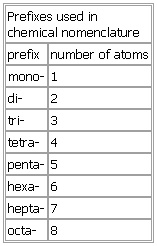- Prefixes used in chemical nomenclature
-
▪ TablePrefixes used inchemical nomenclatureprefix number of atomsmono- 1di- 2tri- 3tetra- 4penta- 5hexa- 6hepta- 7octa- 8See as table:

* * *
Universalium. 2010.

* * *
Universalium. 2010.
chemical compound — Introduction any substance composed of identical molecules consisting of atoms (atom) of two or more chemical elements (chemical element). All the matter in the universe is composed of the atoms of more than 100 different chemical elements … Universalium
IUPAC nomenclature of organic chemistry — The IUPAC nomenclature of organic chemistry is a systematic method of naming organic chemical compounds as recommended[1] by the International Union of Pure and Applied Chemistry (IUPAC). Ideally, every possible organic compound should have a… … Wikipedia
IUPAC nomenclature of inorganic chemistry — For the current Red Book version, see IUPAC nomenclature of inorganic chemistry 2005. The IUPAC nomenclature of inorganic chemistry is a systematic method of naming inorganic chemical compounds, as recommended by the International Union of Pure… … Wikipedia
Oligosaccharide nomenclature — Oligosaccharides and polysaccharides are an important class of polymeric carbohydrates found in virtually all living entities.[1] Their structural features make their nomenclature challenging and their roles in living systems make their… … Wikipedia
List of medical roots, suffixes and prefixes — This is a list of roots, suffixes, and prefixes used in medical terminology, their meanings, and their etymology. There are a few rules when using medical roots. Firstly, prefixes and suffixes, primarily in Greek, but also in Latin, have a… … Wikipedia
IUPAC nomenclature of inorganic chemistry 2005 — The IUPAC Recommendations 2005, Nomenclature of Inorganic Chemistry replaces their previous recommendations Nomenclatureof Inorganic Chemistry, IUPAC Recommendations 1990 (Red Book I) , and where appropriate (sic) Nomenclature of Inorganic… … Wikipedia
Dihydrogen monoxide hoax — Dihydrogen monoxide redirects here. For the H2O molecule, see Properties of water. Water consists of two hydrogen atoms and one oxygen atom. In the dihydrogen monoxide hoax, water is called by an unfamiliar name, dihydrogen monoxide , followed by … Wikipedia
steroid — /stear oyd, ster /, Biochem. n. 1. any of a large group of fat soluble organic compounds, as the sterols, bile acids, and sex hormones, most of which have specific physiological action. adj. 2. Also, steroidal /sti royd l, ste /. pertaining to or … Universalium
Number prefix — Number prefixes are prefixes derived from numbers or numerals. In English and other European languages, they are used to coin numerous series of words, such as unicycle – bicycle – tricycle, dyad – triad – decade, biped – quadruped, September –… … Wikipedia
Nor- — In chemical nomenclature, nor is a prefix to name a structural analog that can be derived from a parent compound by the removal of one carbon atom along with the accompanying hydrogen. The nor compound can be derived by demethylation or by… … Wikipedia